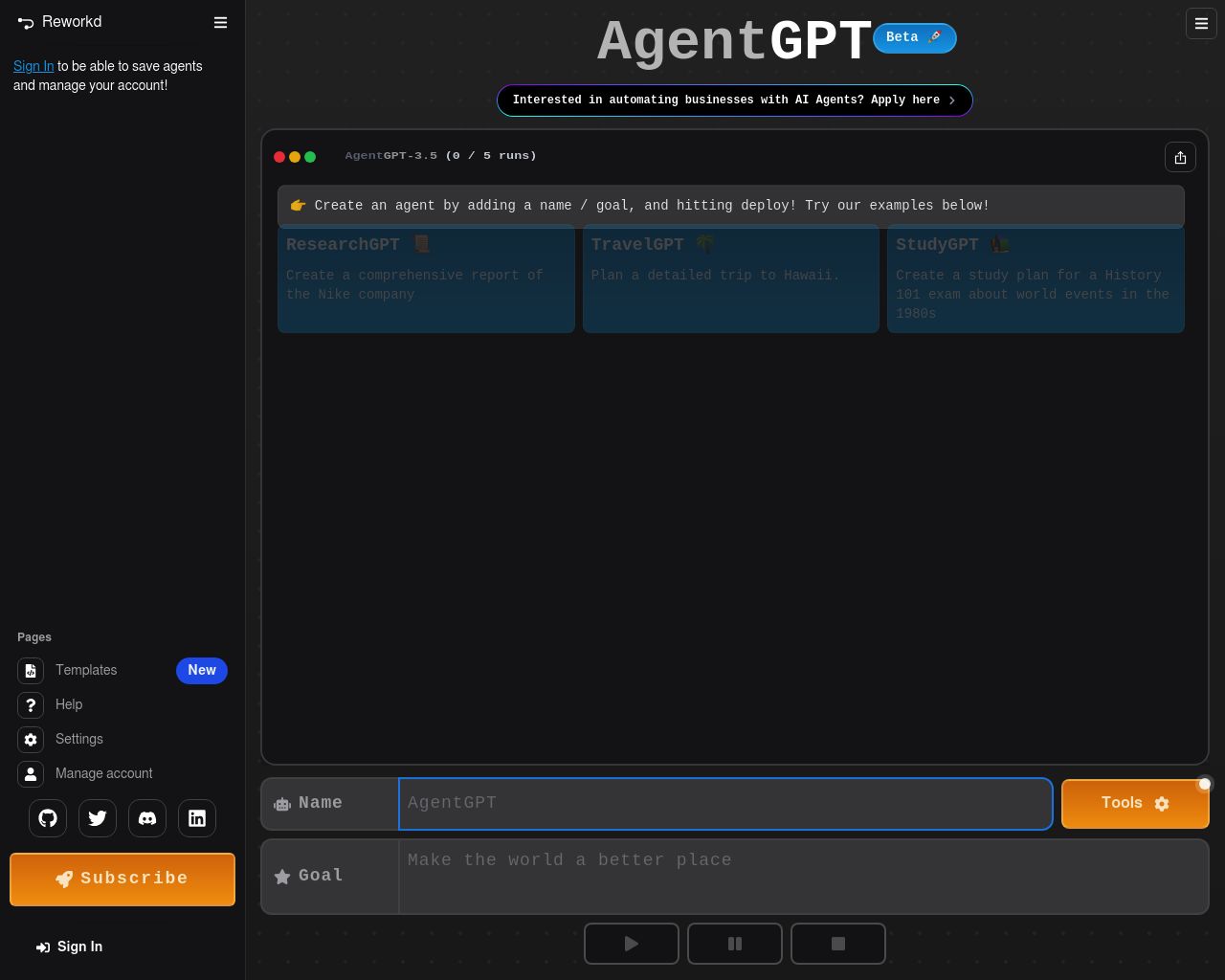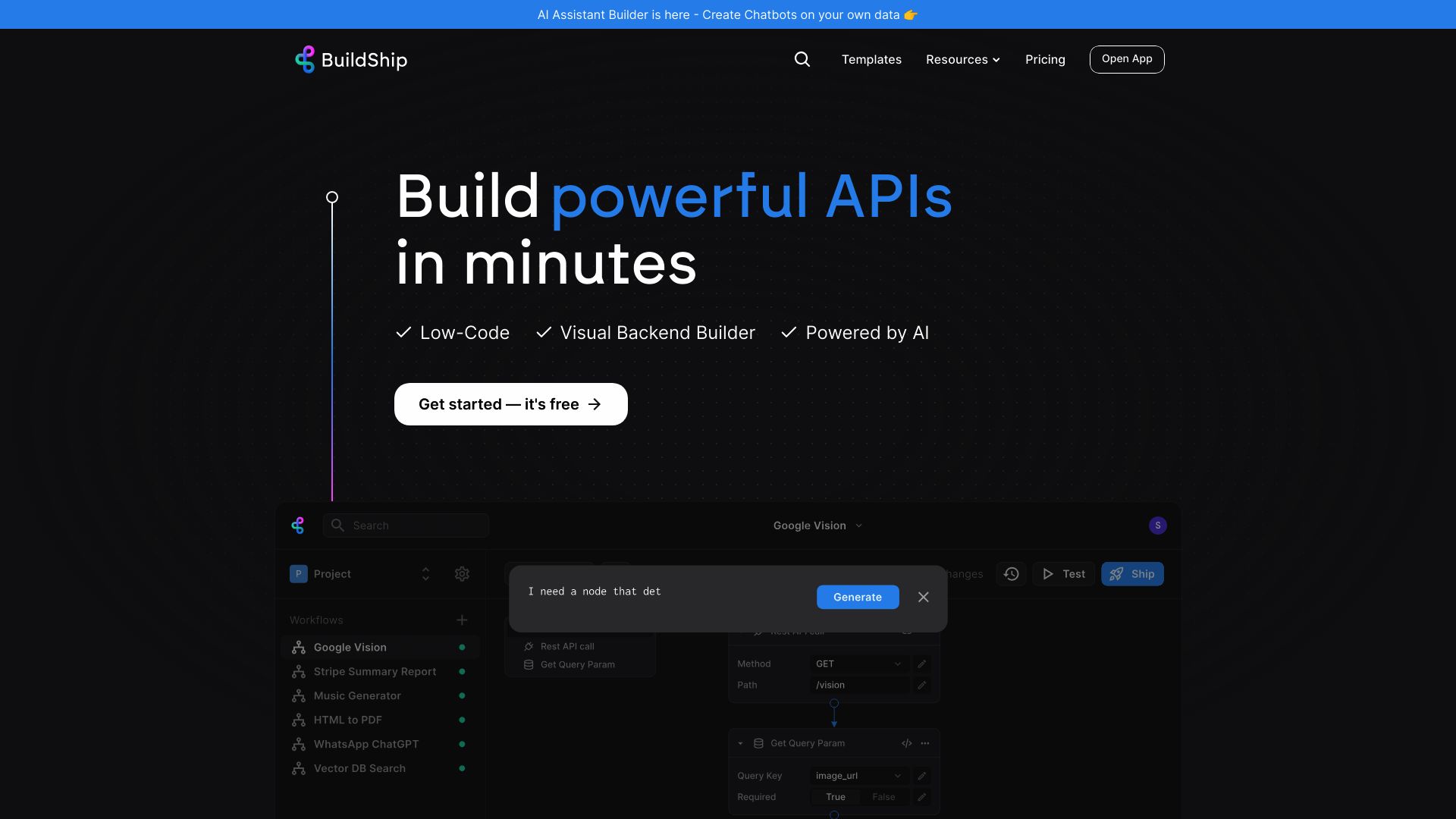AgentGPT vs. BuildShip: Comparing AI Automation Platforms
AI-powered automation platforms revolutionize how businesses operate, but choosing the right solution can be daunting. This comparison dives deep into AgentGPT vs. BuildShip, two innovative tools reshaping the AI landscape. AgentGPT excels in creating autonomous agents for broad tasks, while BuildShip streamlines backend workflow automation.
We’ll explore their unique strengths, limitations, and how they stack up against SmythOS, a comprehensive platform that combines the best of both worlds. Whether you’re a developer seeking powerful APIs, a business leader focused on scalability, or a non-technical user looking for accessible AI tools, this analysis will guide you towards the ideal solution for your AI automation needs.
AgentGPT Overview
AgentGPT empowers users to create and deploy autonomous AI agents directly in a web environment. Unlike traditional conversational AI, AgentGPT focuses on executing broad, goal-oriented tasks. The platform’s web-based interface sets it apart from locally-operated alternatives, offering accessibility and scalability.
Users benefit from AgentGPT’s robust feature set, including user authentication, agent run saving and sharing, dynamic translations, and AI model customization. The platform’s web browsing capabilities expand its utility, while backend migration to Python and Stripe integration enhance its performance and monetization options.
AgentGPT empowers users to create and deploy autonomous AI agents directly in a web environment. Unlike traditional conversational AI, AgentGPT focuses on executing broad, goal-oriented tasks.


AgentGPT leverages vector databases for memory management, enabling AI agents to retain execution history and access long-term memory. This feature significantly enhances agent functionality over extended periods. The platform’s accessibility through docker-compose, without requiring an API key for local runs, appeals to developers seeking flexibility and control.
AgentGPT leverages vector databases for memory management, enabling AI agents to retain execution history and access long-term memory.
While AgentGPT offers powerful capabilities, it lacks some advanced features found in other platforms. The absence of a visual builder or no-code editor may limit its appeal to non-technical users. Additionally, the platform does not appear to offer multi-agent collaboration or specialized deployment options like webhooks or scheduled agents.
Despite these limitations, AgentGPT’s commitment to open-source development and continuous improvement through community contributions positions it as a dynamic player in the AI agent landscape. Its focus on empowering individuals and businesses with accessible AI tools aligns with the growing demand for efficient, intelligent automation solutions.
BuildShip Overview
BuildShip empowers users to create, test, and deploy backend workflows and APIs without extensive coding knowledge. The platform’s visual no-code interface streamlines the development process, allowing teams to build complex automations efficiently.
At its core, BuildShip offers a drag-and-drop workflow builder with pre-built nodes and AI-generated custom nodes. Users can integrate various data sources, APIs, and AI models to construct powerful workflows. The platform supports custom logic in JavaScript or TypeScript for more advanced requirements. BuildShip’s testing capabilities enable iterative development, with options to test individual nodes or entire workflows before deployment.
BuildShip empowers users to create, test, and deploy backend workflows and APIs without extensive coding knowledge. The platform’s visual no-code interface streamlines the development process…
BuildShip stands out with its AI-powered features, including natural language prompts for node creation and input autofill. The platform also prioritizes security, offering secure storage for API keys and secrets. Deployment options allow users to transform their workflows into production-grade APIs, integrating seamlessly into existing applications. Additionally, BuildShip provides scheduling functionality for automated workflow execution.


While BuildShip excels in workflow automation and API creation, it lacks some advanced features found in comprehensive AI agent platforms. The absence of hosted AI agents, autonomous agent capabilities, and multi-agent collaboration may limit its applicability for complex AI projects. However, for businesses and developers focused on streamlining backend processes and creating efficient APIs, BuildShip offers a powerful and accessible solution.
Feature Comparison
AgentGPT and BuildShip offer distinct approaches to AI-powered automation, each with its own strengths and limitations. AgentGPT excels in creating autonomous AI agents capable of executing broad, goal-oriented tasks. Its web-based platform leverages vector databases for memory management, enabling agents to retain execution history and access long-term memory. This feature significantly enhances agent functionality over extended periods.
In contrast, BuildShip focuses on backend workflow automation and API creation without requiring extensive coding knowledge. Its visual no-code interface streamlines the development process, allowing teams to build complex automations efficiently. BuildShip’s AI-powered features, including natural language prompts for node creation and input autofill, set it apart in the workflow automation space.
However, AgentGPT lacks some advanced features found in other platforms. The absence of a visual builder or no-code editor may limit its appeal to non-technical users. Additionally, AgentGPT does not appear to offer multi-agent collaboration or specialized deployment options like webhooks or scheduled agents. BuildShip, while excelling in workflow automation, lacks the autonomous agent capabilities and multi-agent collaboration features that AgentGPT provides.
Both platforms have gaps in their security features. Neither explicitly mentions data encryption or IP control capabilities, which are crucial for enterprise-level deployments. BuildShip’s focus on backend workflows and APIs may provide more robust integration options, but it lacks the broad problem-solving capabilities of AgentGPT’s autonomous agents.
Feature Comparison Table
| AgentGPT | BuildShip | SmythOS | |
|---|---|---|---|
| CORE FEATURES | |||
| Visual Builder | ❌ | ✅ | ✅ |
| No-Code Options | ❌ | ✅ | ✅ |
| Memory & Context | ✅ | ❌ | ✅ |
| Autonomous Agents | ✅ | ❌ | ✅ |
| Explainability & Transparency | ❌ | ❌ | ✅ |
| Multimodal | ✅ | ❌ | ✅ |
| Problem-Solving Capabilities | ✅ | ❌ | ✅ |
| Multi-Agent Collaboration | ✅ | ❌ | ✅ |
| Human-AI Interaction | ❌ | ❌ | ✅ |
| Audit Logs for Analytics | ✅ | ❌ | ✅ |
| Work as Team | ✅ | ❌ | ✅ |
| SECURITY | |||
| Constrained Alignment | ❌ | ❌ | ✅ |
| IP Control | ❌ | ✅ | ✅ |
| COMPONENTS | |||
| Foundation AIs | ❌ | ❌ | ✅ |
| Huggingface AIs | ✅ | ❌ | ✅ |
| Zapier APIs | ✅ | ❌ | ✅ |
| Classifiers | ✅ | ❌ | ✅ |
| Data Lakes | ❌ | ❌ | ✅ |
| DEPLOYMENT OPTIONS (EMBODIMENTS) | |||
| Staging Domains | ❌ | ❌ | ✅ |
| Production Domains | ❌ | ❌ | ✅ |
| Deploy as Site Chat | ✅ | ❌ | ✅ |
| Deploy as Scheduled Agent | ❌ | ✅ | ✅ |
| Deploy as GPT | ✅ | ❌ | ✅ |
| DATA LAKE SUPPORT | |||
| Hosted Vector Database | ✅ | ❌ | ✅ |
| Sitemap Crawler | ❌ | ❌ | ✅ |
| YouTube Transcript Crawler | ❌ | ❌ | ✅ |
| URL Crawler | ✅ | ❌ | ✅ |
| PDF Support | ✅ | ❌ | ✅ |
| Word File Support | ✅ | ❌ | ✅ |
| TXT File Support | ✅ | ❌ | ✅ |
Best Alternative to AgentGPT and BuildShip
SmythOS emerges as the superior alternative to AgentGPT and BuildShip, offering a comprehensive platform for AI agent development and deployment. Our solution combines powerful features with user-friendly interfaces, making advanced AI capabilities accessible to users of all skill levels.
Unlike AgentGPT’s limited customization options and BuildShip’s focus on backend workflows, SmythOS provides a versatile drag-and-drop interface for creating sophisticated AI agents. We support a wide range of AI models, including those from OpenAI, Anthropic, and Hugging Face, giving users unparalleled flexibility in agent design.
SmythOS provides a versatile drag-and-drop interface for creating sophisticated AI agents… giving users unparalleled flexibility in agent design.
SmythOS excels in multi-agent collaboration, a feature absent in BuildShip and limited in AgentGPT. Our platform enables teams of AI agents to work together on complex tasks, significantly enhancing productivity and problem-solving capabilities. This collaborative approach sets SmythOS apart in handling intricate business processes and data analysis.
Security and scalability are paramount in SmythOS. We offer robust data encryption, OAuth integration, and IP control features, addressing enterprise-level security concerns that AgentGPT and BuildShip may overlook. Our platform seamlessly scales from small projects to large-scale deployments, ensuring consistent performance as your needs grow.
With SmythOS, you’re not just building AI agents; you’re creating a future-proof AI ecosystem for your organization. Our platform’s extensive integration capabilities, advanced deployment options, and support for various data formats make it the ideal choice for businesses looking to leverage AI across multiple domains and use cases.
Conclusion
AgentGPT and BuildShip offer unique approaches to AI-powered automation, each with distinct strengths. AgentGPT excels in creating autonomous AI agents for broad, goal-oriented tasks, while BuildShip focuses on streamlining backend workflow automation and API creation.
Despite their individual merits, both platforms fall short in key areas. AgentGPT lacks a visual builder and multi-agent collaboration, limiting its appeal to non-technical users. BuildShip, while strong in workflow automation, doesn’t provide the autonomous agent capabilities that AgentGPT offers. Both platforms also have gaps in enterprise-level security features.
SmythOS emerges as the superior choice, addressing the limitations of both AgentGPT and BuildShip while offering a comprehensive suite of features. Our platform combines the best of both worlds: autonomous AI agents, visual workflow building, and robust API integrations. SmythOS’s drag-and-drop interface makes AI development accessible to users of all skill levels, while our extensive integration ecosystem ensures compatibility with virtually any workflow or business process.
With SmythOS, you can create and deploy AI agents across multiple platforms, from chatbots to APIs, with our unique “Create Once, Deploy Anywhere” approach. Our multi-agent orchestration capabilities, coupled with advanced features like data lake support and scalable embodiments, position SmythOS as the ideal solution for businesses seeking to harness the full potential of AI.
Ready to experience the future of AI automation? Create a free SmythOS account today and start building powerful AI agents with no time limit. Explore our diverse range of AI-powered agent templates to jumpstart your projects, or dive into our comprehensive documentation to unlock the full potential of SmythOS. Join us in revolutionizing how businesses leverage AI – your journey to unprecedented efficiency and innovation starts here.
Last updated:
Disclaimer: The information presented in this article is for general informational purposes only and is provided as is. While we strive to keep the content up-to-date and accurate, we make no representations or warranties of any kind, express or implied, about the completeness, accuracy, reliability, suitability, or availability of the information contained in this article.
Any reliance you place on such information is strictly at your own risk. We reserve the right to make additions, deletions, or modifications to the contents of this article at any time without prior notice.
In no event will we be liable for any loss or damage including without limitation, indirect or consequential loss or damage, or any loss or damage whatsoever arising from loss of data, profits, or any other loss not specified herein arising out of, or in connection with, the use of this article.
Despite our best efforts, this article may contain oversights, errors, or omissions. If you notice any inaccuracies or have concerns about the content, please report them through our content feedback form. Your input helps us maintain the quality and reliability of our information.
